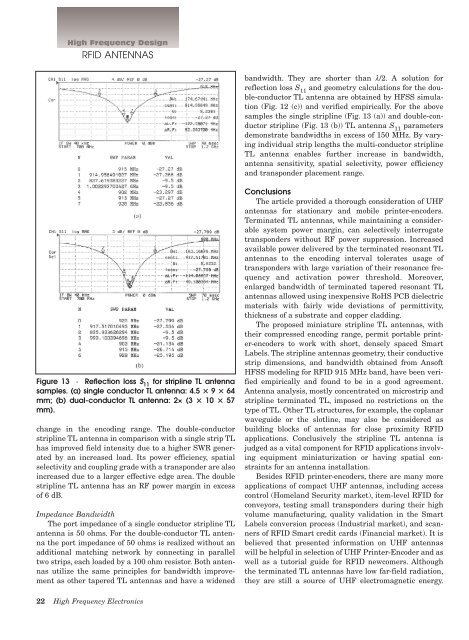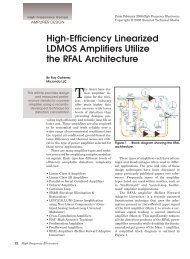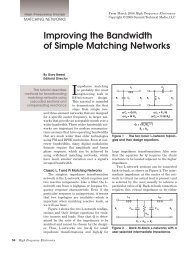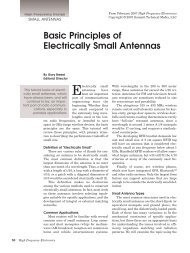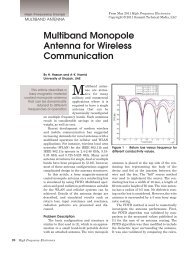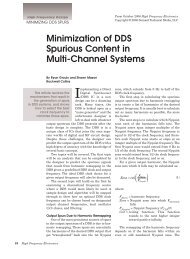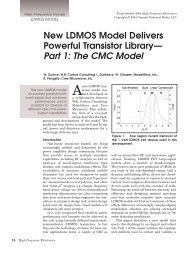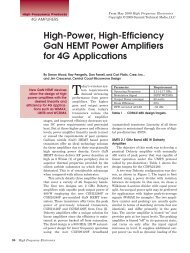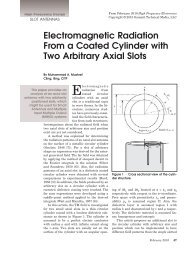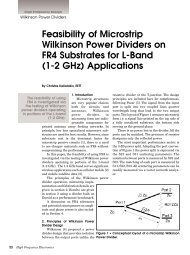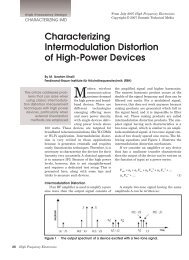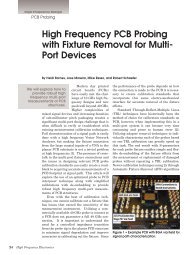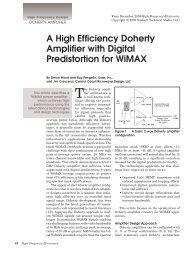UHF RFID Antennas for Printer-Encodersâ Part 3 - High Frequency ...
UHF RFID Antennas for Printer-Encodersâ Part 3 - High Frequency ...
UHF RFID Antennas for Printer-Encodersâ Part 3 - High Frequency ...
You also want an ePaper? Increase the reach of your titles
YUMPU automatically turns print PDFs into web optimized ePapers that Google loves.
<strong>High</strong> <strong>Frequency</strong> Design<br />
<strong>RFID</strong> ANTENNAS<br />
bandwidth. They are shorter than λ/2. A solution <strong>for</strong><br />
reflection loss S 11<br />
and geometry calculations <strong>for</strong> the double-conductor<br />
TL antenna are obtained by HFSS simulation<br />
(Fig. 12 (c)) and verified empirically. For the above<br />
samples the single stripline (Fig. 13 (a)) and double-conductor<br />
stripline (Fig. 13 (b)) TL antenna S 11<br />
parameters<br />
demonstrate bandwidths in excess of 150 MHz. By varying<br />
individual strip lengths the multi-conductor stripline<br />
TL antenna enables further increase in bandwidth,<br />
antenna sensitivity, spatial selectivity, power efficiency<br />
and transponder placement range.<br />
Figure 13 · Reflection loss S 11<br />
<strong>for</strong> stripline TL antenna<br />
samples. (a) single conductor TL antenna: 4.5 × 9 × 64<br />
mm; (b) dual-conductor TL antenna: 2× (3 × 10 × 57<br />
mm).<br />
change in the encoding range. The double-conductor<br />
stripline TL antenna in comparison with a single strip TL<br />
has improved field intensity due to a higher SWR generated<br />
by an increased load. Its power efficiency, spatial<br />
selectivity and coupling grade with a transponder are also<br />
increased due to a larger effective edge area. The double<br />
stripline TL antenna has an RF power margin in excess<br />
of 6 dB.<br />
Impedance Bandwidth<br />
The port impedance of a single conductor stripline TL<br />
antenna is 50 ohms. For the double-conductor TL antenna<br />
the port impedance of 50 ohms is realized without an<br />
additional matching network by connecting in parallel<br />
two strips, each loaded by a 100 ohm resistor. Both antennas<br />
utilize the same principles <strong>for</strong> bandwidth improvement<br />
as other tapered TL antennas and have a widened<br />
Conclusions<br />
The article provided a thorough consideration of <strong>UHF</strong><br />
antennas <strong>for</strong> stationary and mobile printer-encoders.<br />
Terminated TL antennas, while maintaining a considerable<br />
system power margin, can selectively interrogate<br />
transponders without RF power suppression. Increased<br />
available power delivered by the terminated resonant TL<br />
antennas to the encoding interval tolerates usage of<br />
transponders with large variation of their resonance frequency<br />
and activation power threshold. Moreover,<br />
enlarged bandwidth of terminated tapered resonant TL<br />
antennas allowed using inexpensive RoHS PCB dielectric<br />
materials with fairly wide deviations of permittivity,<br />
thickness of a substrate and copper cladding.<br />
The proposed miniature stripline TL antennas, with<br />
their compressed encoding range, permit portable printer-encoders<br />
to work with short, densely spaced Smart<br />
Labels. The stripline antennas geometry, their conductive<br />
strip dimensions, and bandwidth obtained from Ansoft<br />
HFSS modeling <strong>for</strong> <strong>RFID</strong> 915 MHz band, have been verified<br />
empirically and found to be in a good agreement.<br />
Antenna analysis, mostly concentrated on microstrip and<br />
stripline terminated TL, imposed no restrictions on the<br />
type of TL. Other TL structures, <strong>for</strong> example, the coplanar<br />
waveguide or the slotline, may also be considered as<br />
building blocks of antennas <strong>for</strong> close proximity <strong>RFID</strong><br />
applications. Conclusively the stripline TL antenna is<br />
judged as a vital component <strong>for</strong> <strong>RFID</strong> applications involving<br />
equipment miniaturization or having spatial constraints<br />
<strong>for</strong> an antenna installation.<br />
Besides <strong>RFID</strong> printer-encoders, there are many more<br />
applications of compact <strong>UHF</strong> antennas, including access<br />
control (Homeland Security market), item-level <strong>RFID</strong> <strong>for</strong><br />
conveyors, testing small transponders during their high<br />
volume manufacturing, quality validation in the Smart<br />
Labels conversion process (Industrial market), and scanners<br />
of <strong>RFID</strong> Smart credit cards (Financial market). It is<br />
believed that presented in<strong>for</strong>mation on <strong>UHF</strong> antennas<br />
will be helpful in selection of <strong>UHF</strong> <strong>Printer</strong>-Encoder and as<br />
well as a tutorial guide <strong>for</strong> <strong>RFID</strong> newcomers. Although<br />
the terminated TL antennas have low far-field radiation,<br />
they are still a source of <strong>UHF</strong> electromagnetic energy.<br />
22 <strong>High</strong> <strong>Frequency</strong> Electronics


